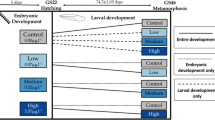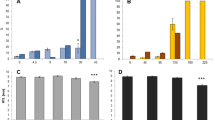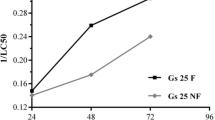Abstract
Herbicides are the most common agrochemicals used in crops. Among them, glyphosate is the most widely applied in the world. Herbicides, especially organophosphates, have been shown to be hazardous to non-target species, including amphibians. The present study evaluated the acute and chronic effects of glyphosate-based herbicide (GBH), Roundup original® DI on tadpoles from two South American native species, Physalaemus cuvieri and P. gracilis. Spawnings were collected in the natural environment and maintained in the laboratory under controlled conditions. Acute and chronic toxicology trials began at stage 25 of Gosner (Herpetological 16:183–190, 1960). In an acute toxicity assay, seven GBH concentrations between 100 and 4500 μg a.e./L were tested over 96 h. For the chronic trials, tadpoles were subjected to both doses allowed by Brazilian legislation and to concentrations found in natural environment waters from Brazil and Argentina, between 65 and 1000 μg a.e/L over 14 days. Glyphosate had lethal effects on both studied species. Tadpoles showed shorter lengths and lower masses; that is, those that survived suffered chronic effects on growth and weight. The GBH maximum acceptable toxicant concentration for mortality and malformation was lower than the allowed level for Brazilian waters. The GBH tested in this study presented a high environmental and acute risk for the two studied species.






Similar content being viewed by others
References
Achaval F, Olmos A (2003) Anfibios y Reptiles del Uruguay. In: Achaval F, Olmos A (eds) Anfibios y reptiles del Uruguay. Facultad de Ciencias, Montevideo, p 136 (in Spanish)
Agostini MG, Roesler I, Bonetto C, Ronco AE, Bilenca D (2020) Pesticides in the real world: the consequences of GMO-based intensive agriculture on native amphibians. Biol Conserv 241:108355. https://doi.org/10.1016/j.biocon.2019.108355
Avigliano E, Schenone NF (2015) Human health risk assessment and environmental distribution of trace elements, glyphosate, fecal coliform and total coliform in Atlantic rainforest mountain rivers (South America). Microchem J 122:149–158. https://doi.org/10.1016/j.microc.2015.05.004
Bach NC, Marino DJG, Natale GS, Somoza GM (2018) Effects of glyphosate and its commercial formulation, roundup® Ultramax, on liver histology of tadpoles of the neotropical frog, Leptodactylus latrans (amphibia: Anura). Chemosphere 202:289–297. https://doi.org/10.1016/j.chemosphere.2018.03.110
Barreto L, Andrade GV (1995) Aspects of the reproductive biology of Physalaemus cuvieri (Anura: Leptodactylidae) in northeastern Brazil. Amphibia-Reptilia 16:67–76. https://doi.org/10.1163/156853895X00208
Battaglin WA, Smalling KL, Anderson C, Calhoun D, Chestnut T, Muths E (2016) Potential interactions among disease, pesticides, water quality and adjacent land cover in amphibian habitats in the United States. Sci Total Environ 567:320–332. https://doi.org/10.1016/j.scitotenv.2016.05.062
Beckie HJ, Flower KC, Ashworth MB (2020) Farming without glyphosate? Plants. 9. https://doi.org/10.3390/plants9010096
Benbrook CM (2018) Why regulators lost track and control of pesticide risks: lessons from the case of glyphosate-based herbicides and genetically engineered-crop technology. Curr Envir Health Rpt 5:387–395. https://doi.org/10.1007/s40572-018-0207-y
Bonfanti P, Saibene M, Bacchetta R, Mantecca P, Colombo A (2018) A glyphosate micro-emulsion formulation displays teratogenicity in Xenopus laevis. Aquat Toxicol 195:103–113. https://doi.org/10.1016/j.aquatox.2017.12.007
Bosch B, Mañas F, Gorla N, Aiassa D (2011) Micronucleus test in post metamorphic Odontophrynus cordobae and Rhinella arenarum (Amphibia: Anura) for environmental monitoring. J Toxicol Environ Health Sci 3:155–163
Brazil (2005) Resolução CONAMA n°357 de 17 de março de 2005. http://www.mma.gov.br/port/conama/res/res05/res35705.pdf. Accessed 06 Jan 2020 (in Portuguese)
Brazil (2011) Portaria do Ministério da Saúde, 2914 de 12 de dezembro de 2011. Health Ministry. http://bvsms.saude.gov.br/bvs/saudelegis/gm/2011/prt2914_12_12_2011.html. Accessed 06 Jan 2020 (in Portuguese)
Britson C, Threlkeld S (1998) Abundance, metamorphosis, developmental, and behavioral abnormalities in Hyla chrysoscelis tadpoles following exposure to three agrichemicals and methyl mercury in outdoor mesocosms. Bull Environ Contam Toxicol 61:154–161. https://doi.org/10.1007/s001289900742
Camargo A, Sarroca M, Maneyro R (2008) Reproductive effort and the egg number vs. size tradeoff in Physalaemus frogs (Anura: Leiuperidae). Acta Oecol 34:163–171. https://doi.org/10.1016/j.actao.2008.05.003
Catenazzi A (2015) State of the World's amphibians. Annu Rev Environ Resour 40:91–11. https://doi.org/10.1146/annurev-environ-102014-021358
Ceron K, Martins HB, Zocche JJ (2016) Anurans of a remnant forest in Urussanga, Santa Catarina, southern of Brazil. Check List 12:949–963. https://doi.org/10.15560/12.6.2014
Colombo P, Kindel A, Vinciprova G, Krause L (2008) Composition and threats for conservation of anuran amphibians from Itapeva State Park, Municipality of Torres, Rio Grande do Sul, Brazil. Biota Neotrop 8:229–240. https://doi.org/10.1590/S1676-06032008000300020
CONCEA (2015) Conselho Nacional de Controle De Experimentação animal. Diretriz da Prática de Eutanásia do CONCEA. Ministério da Ciência, Tecnologia e Inovação, Brasília/DF (in Portuguese)
Costa RN, Nomura F (2016) Measuring the impacts of Roundup Original® on fluctuating asymmetry and mortality in a Neotropical tadpole. Hydrobiologia 765:85–96. https://doi.org/10.1007/s10750-015-2404-0
Cuhra M, Bøhn T, Cuhra P (2016) Glyphosate: too much of a good thing? Front Environ Sci 4:28. https://doi.org/10.3389/fenvs.2016.00028
Edginton A, Sheridan PM, Stephenson GR, Thompson DG, Boermans HJ (2004) Comparative effects of pH and Vision® herbicide on two life stages of four anuran amphibian species. Environ Toxicol Chem 23:815–822
Feder ME (1982) Responses to acute aquatic hypoxia in larvae of the frog Rana berlandieri. J Exp Zool 220:33–43
Freire R, Schneider RM, Freitas FH, Bonifácio CM, Tavares CRG (2012) Monitoring of toxic chemical in the basin of Maringá stream. Acta Sci Technol 34:295–302. https://doi.org/10.4025/actascitechnol.v34i3.10302
Frost DR (2020) Amphibian species of the world: an online reference. Version 6.0 (Date of access). Electronic database accessible at http://research.amnh.org/herpetology/amphibia/index.html. American Museum of Natural History, New York, USA. Accessed 16 Jan 2020. https://doi.org/10.5531/db.vz.0001
Giesy J, Dobson S, Solomon K (2000) Ecotoxicological risk assessment for Roundup® herbicide. Rev Environ Contam Toxicol 167:35–120
Gill JPK, Sethi N, Mohan A, Datta S, Girdhar M (2018) Glyphosate toxicity for animals. Environ Chem Lett 16:401–266. https://doi.org/10.1007/s10311-017-0689-0
Gomes MP, Tavares DS, Richardi VS, Marques RZ, Wistuba N, Brito JCM, Soffiatti P, Sant’Anna-Santos BF, Navarro Silva MAN, Juneau P (2019) Enrofloxacin and roundup® interactive effects on the aquatic macrophyte Elodea canadensis physiology. Environ Pollut 249:453–462. https://doi.org/10.1016/j.envpol.2019.03.026
Gosner KL (1960) A simplified table for staging anuran embryos and larvae with notes on identification. Herpetological 16:183–190
Guyton KZ, Loomis D, Grosse Y, El Ghissassi F, Benbrahim-Tallaa L, Guha N et al (2015) Carcinogenicity of tetrachlorvinphos, parathion, malathion, diazinon, and glyphosate. Lancet Oncol 16:490491–490491. https://doi.org/10.1016/S1470-2045(15)70134-8
Hamilton MA, Russo CR, Thurston RV (1977) Trimmed spearman - Karber method for estimating median lethal concentrations in toxicity biossays. Environ Sci Technol 7:714–719
Harper EB, Rittenhouse TAG, Semlitsch RD (2008) Demographic consequences of terrestrial habitat loss for pool-breeding amphibians: predicting extinction risks associated with inadequate size of buffer zones. Conserv Biol 22:1205–1215
Hayes T (1997) Hormonal mechanisms as potential constraints on evolution: examples from the Anura. Am Zool 37:482–490
Hayes TB, Stuart AA, Mendoza M, Collins A, Noriega N, Vonk A, Johnston G, Liu R, Kpodzo D (2006) Characterization of atrazine induced gonadal malformations and effects of an androgen antagonist (cyproterone acetate) and exogenous estrogen (estradiol 17β): support for the demasculinization/feminization hypothesis. Environ Health Perspect 114:134–141. https://doi.org/10.1289/ehp.8067
Howe CM, Berrill M, Pauli BD, Helbing CC, Werry K, Veldhoen N (2004) Toxicity of glyphosate-based pesticides to four north American frog species. Environ Toxicol Chem 8:1928–1938
Hu L, Zhu J, Rotchell JM, Wu L, Gao J, Shi H (2015) Use of the enhanced frog embryo teratogenesis assay-Xenopus (FETAX) to determine chemically-induced phenotypic effects. Sci Total Environ 50:258–265. https://doi.org/10.1016/2014.11.086
Islam A, Malik MF (2018) Impact of pesticides on amphibians: a review. J Toxicol Anal 1:1–4
Jones DK, Hammond JI, Relyea RA (2010) Roundup and amphibians: the importance of concentration, application time, and stratification. Environ Toxicol Chem 29:2016–2025. https://doi.org/10.1002/etc.240
Jung RE, Jagoe CH (1995) Effects of low pH and aluminium on body size, swimming performance and suceptility to predation of green tree frog (Hyla cinerea) tadpole. Can J Zool 73:2171–2183
Lajmanovich RC, Sandoval MT, Peltzer PM (2003) Induction of mortality and malformation in Scinax nasicus tadpoles exposed to glyphosate formulations. Bull Environ Contam Toxicol 70:612–618. https://doi.org/10.1007/s00128-003-0029-x
Lanctôt C, Navarro-Martín L, Robertson C, Park B, Jackman P, Pauli DB, Trudeau VL (2014) Effects of glyphosate-based herbicides on survival, development, growth and sex ratios of wood frog Lithobates sylvaticus tadpoles. II: agriculturally relevant exposures to Roundup WeatherMax® andVision® under laboratory conditions. Aquat Toxicol 154:291–303. https://doi.org/10.1016/j.aquatox.2014.05.025
Lannoo MJ, Petersen C, Lovich RE, Nanjappa P, Phillips C, Mitchell JC, Macallister I (2011) Do frogs get their kicks on route 66? Continental U.S. transect reveals spatial and temporal patterns of Batrachochytrium dendrobatidis infection. Plos One. https://doi.org/10.1371/journal.pone.0022211
Lavilla E, Kwet A, Segalla MV, Langone J, Baldo D (2010) Physalaemus gracilis. The IUCN Red List of Threatened Species. https://doi.org/10.2305/IUCN.UK.2010-2.RLTS.T57258A11610839.en
Lenhardt PP, Bruhla CA, Berger GERT (2015) Temporal coincidence of amphibian migration and pesticide applications on arable fields in spring. Basic Appl Ecol 16:54–63. https://doi.org/10.1016/j.baae.2014.10.005
Mathew DV, Wassersug RJ, Parris MJ (2010) How does a change in labial tooth row number affect feeding kinematics and foraging performance of a ranid tadpole Lithobates sphenocephalus? Biol Bull 218:160–168
Mattos ML, Peralba T, Dias MCR, Prata SLPF, Camargo L (2002) Monitoramento ambiental do glyphosate e do seu metabólito (ácido aminometilfosfônico) na água de lavoura de arroz irrigado. Pesticidas: Rev Ecotoxicol Meio Amb 12:145–154 (in Portuguese)
Mijares A, Rodrigues MT, Baldo D (2010) Physalaemus cuvieri. IUCN Red List. http://www.iucnredlist.org/details/57250/0. Accessed 22 Feb 2019
Perez LG, Vera MS, Miranda AL (2011) Effects of herbicide glyphosate and glyphosate – based formulations on aquatic ecosystems. Herbicides Environ. https://doi.org/10.5772/12877
Peruzzo PJ, Porta AA, Ronco AE (2008) Levels of glyphosate in surface waters, sediments and soils associated with direct sowing soybean cultivation in North Pampasic Region of Argentina. Environ Pollut 156:61–66
Reeves RA (2014) Amphibian stress, survival, and habitat quality in restored agricultural wetlands in Central Iowa. State University Ames, Tesis
Ronco AE, Carriquiriborde P, Natale GS, Martin ML, Mugni H, Bonetto C (2008) Integrated approach for the assessment of biotech soybean pesticides impact on low order stream ecosystems of the Pampasic Region. In: Chen J, Guo C (eds) Ecosystem ecology research trends. Nova Science Publishers, New York, pp 209–239
Solomon KR (2016) Glyphosate in the general population and in applicators: a critical review of studies on exposures. Crit Rev Toxicol 46:21–27. https://doi.org/10.1080/10408444.2016.1214678
Solomon KR, Thompson DG (2003) Ecological risk assessment for aquatic organisms from over-water uses of glyphosate. J Toxicol Environ Health 6:211–246
Tapley B, Michaels CJ, Gumbs R, Böhm M, Luedtke J, Pearce-Kelly P, Rowleyfg JJL (2018) The disparity between species description and conservation assessment: a case study in taxa with high rates of species discovery. Biol Conserv 220:209–214. https://doi.org/10.1016/j.biocon.2018.01.022
USEPA, United States Environmental Protection Agency (2017) Technical Overview of Ecological Risk Assessment: Risk Characterization About Risk Characterization. https://www.epa.gov/pesticide-science-and-assessing-pesticide-risks/technical-overview-ecological-risk-assessment-risk. Accessed 18 Feb 2020
Venesky MD, Wasserug RJ, Parris MJ (2010) The impact of variation in labial tooth number on the feeding kinematics of tadpoles of southern leopard frog (Lithobates sphenocephalus). Copeia 3:481–486
Villamar-Ayala CA, Carrera-Cevallos JV, Vasquez-Medrano R, Espinoza-Montero PJ (2019) Fate, eco-toxicological characteristics, and treatment processes applied to water polluted with glyphosate: a critical review. Crit Rev Environ Sci and Technol 49:1476–1514. https://doi.org/10.1080/10643389.2019.1579627
Wagner N, Reichenbecher W, Teichmann H, Tappeser B, Lötters S (2013) Questions concerning the potential impact of glyphosate-based herbicides on amphibians. Environ Toxicol Chem 32:1688–1700. https://doi.org/10.1002/etc.2268
Wagner N, Veith M, Lötters S, Viertel B (2017) Population and life-stage–specific effects of two herbicide formulations on the aquatic development of European common frogs (Rana temporaria). Environ Toxicol Chem 36:190–200. https://doi.org/10.1002/etc.3525
Acknowledgements
We are grateful to Federal University of Fronteira Sul (UFFS) for providing logistical support. Camila F. Rutkoski, Luana Vargas, Natani Macagnan and Suélen V. R. Trindade were supported by fellowship from Fundação de Amparo a Pesquisa do Estado do Rio Grande do Sul—FAPERGS.
Funding
This study is financed in part by the Coordenação de Aperfeiçoamento de Pessoal de Nivel Superior – Brazil (CAPES), finance code 001.
Author information
Authors and Affiliations
Corresponding author
Ethics declarations
Human and animal rights
This study was licenced by IBAMA (54939–1) and authorized by the Ethics Committee for Animal Use of the Federal University of Fronteira Sul (23205.003251/2016–11).
Additional information
Responsible editor: Philippe Garrigues
Publisher’s note
Springer Nature remains neutral with regard to jurisdictional claims in published maps and institutional affiliations.
Rights and permissions
About this article
Cite this article
Herek, J.S., Vargas, L., Trindade, S.A.R. et al. Can environmental concentrations of glyphosate affect survival and cause malformation in amphibians? Effects from a glyphosate-based herbicide on Physalaemus cuvieri and P. gracilis (Anura: Leptodactylidae). Environ Sci Pollut Res 27, 22619–22630 (2020). https://doi.org/10.1007/s11356-020-08869-z
Received:
Accepted:
Published:
Issue Date:
DOI: https://doi.org/10.1007/s11356-020-08869-z




